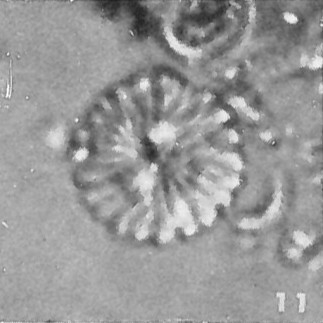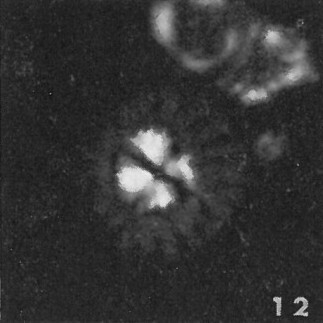Carlamuelleria bramlettei
Set number: 3921
-
1
-
2
-
3
-
4
-
5
-
6
-
7
-
8
-
9
-
10
-
11
-
12
-
13
-
14
-
15
-
16
-
17
-
18
-
19
-
20
-
21
-
22
-
23
-
24
-
25
-
26
-
27
-
28
-
29
-
30
-
31
-
32
10µm
In the mobile mount.
Set number: 3922
-
1
-
2
-
3
-
4
-
5
-
6
-
7
-
8
-
9
-
10
-
11
-
12
-
13
-
14
-
15
-
16
10µm
In the mobile mount
Set number: 3930
-
1
-
2
-
3
-
4
10µm
Set number: 3929
-
1
-
2
-
3
-
4
10µm
Set number: 3928
-
1
-
2
-
3
-
4
-
5
-
6
-
7
-
8
-
9
-
10
-
11
-
12
-
13
-
14
10µm
Set number: 3927
-
1
-
2
-
3
-
4
-
5
-
6
-
7
-
8
-
9
-
10
-
11
-
12
-
13
-
14
-
15
-
16
10µm
In the mobile mount.
Set number: 3926
-
1
-
2
-
3
-
4
10µm
Set number: 3925
-
1
-
2
-
3
-
4
10µm
Set number: 3924
-
1
-
2
-
3
-
4
-
5
-
6
-
7
-
8
10µm
Set number: 3923
-
1
-
2
-
3
-
4
-
5
-
6
-
7
10µm
Discoasteroides bramlettei Bukry and Percival, 1971
Discoaster drieveri Romein, 1980
Emended by Varol, 2023: Large (7.0–11.0 μm) species of Carlamuelleria comprising a non-birefringent distal shield, a birefringent tube cycle and a vestigial diminutive proximal shield. The distal shield is constructed of 17 to 22 segments. The tube cycle and proximal shield resemble a brandy goblet in side view. The tube cycle is often flush with the distal side of the shield.
In cross-polarised light, identifying the curve directions of the inclined (oblique) extinction lines is challenging in plan view. The oblique inclined extinction lines are dextrogyre on the distal side but laevogyre on the proximal side. The interference patterns of the tube cycle (NW-SE) and the shields (NE-SW) occupy opposite positions, as in Markalius (Plate 4, Figs. 14,16 in Varol, 2023). The entire specimen appears birefringent in side view.
In plan view, Carlamuelleria bramlettei is distinguished from other species of Carlamuelleria by having fewer segments in its distal shield (< 22 segments). It differs from subcircular Carlamuelleria karacuhae by having a circular tube cycle, whereas the latter has an elliptical tube cycle. Carlamuelleria bramlettei is easily identified from Davidbukrya specimens in side view by having a tube cycle and a diminutive proximal shield that resembles a brandy goblet. Noelia and Senelia species are differentiated from Carlamuelleria bramlettei by having an appressed proximal shield in their side view. Moreover, the tube cycle distinctly protrudes distally in Noelia.
Carlamuelleria bramlettei also differs in plan view (after mapping its optical properties here) by showing a diagonal interference colour alignment in the tube cycle in cross-polarised light with a gypsum plate. In contrast, specimens of Davidbukrya, Noelia and Senelia have axial interference colour alignment in their tube cycle (i.e., blue sector horizontal on the distal side, vertical on the proximal side).
Bukry, D. & Percival, S. F. 1971. New Tertiary calcareous nannofossils. Tulane Studies in Geology and Paleontology 8: 123-146.
Varol, O. 2023. New paleocene calcareous nannofossils: Carlamuelleria, Davidbukrya, Mauriceblackia, Noelia and Senelia. Marine Micropaleontology. 180: 1-41.

